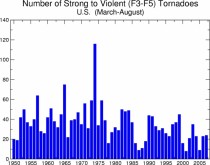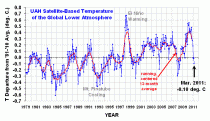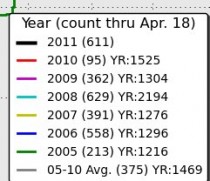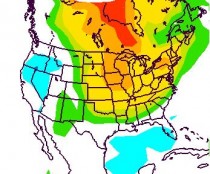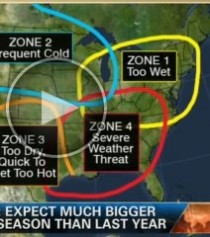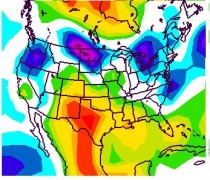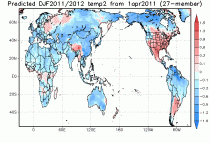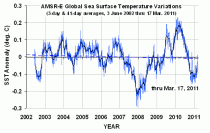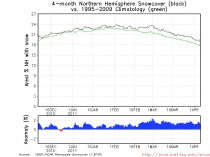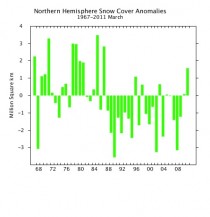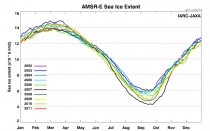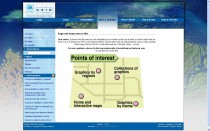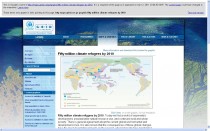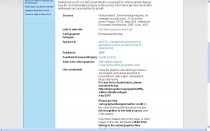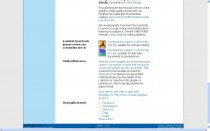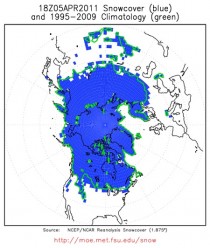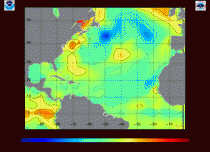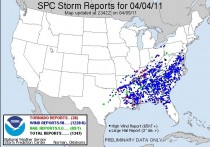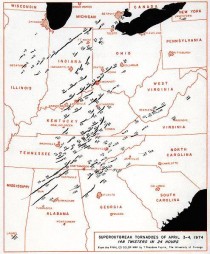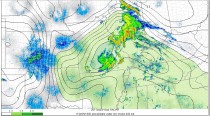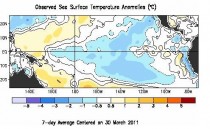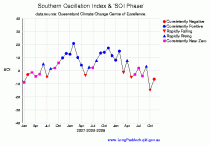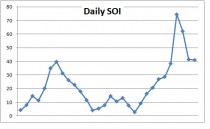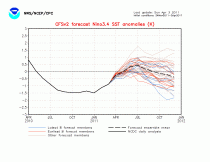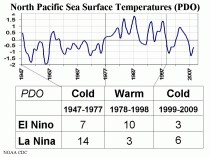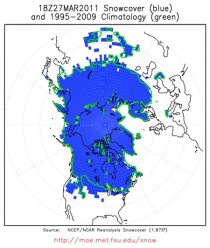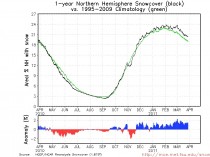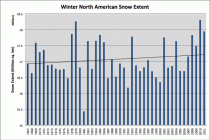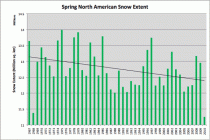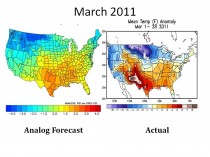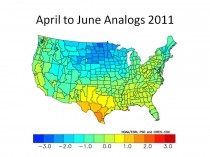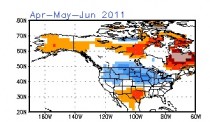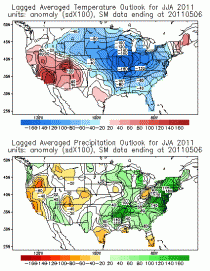By Joe Bastardi, WeatherBell
I simply cant understand the lack of fact finding in this article but I am going to “help” the author by showing him the facts, if he dares too look.
First of all, let’s take a look at actual data on tornadoes
Notice how there were more tornadoes across the US when the climate was colder, the time of the cold PDO back in the 60s and 70s and it has been decreasing since the PDO has warmed...and amazingly since Jim Hansen set the world on Fire in 1988 with his doom and gloom prophecy, the numbers have trended down! The reason they are going up is because we are turning colder again. The last 2 big tornado springs have been after major La Ninas and sharp drops in global temps. Here look at the facts:
THE PDO IS TURNING COLD AGAIN, and when the La Nina came on after the El Nino, 2008 had a major jump from 2007 and now this has occurred. Please look at the facts, here they are:
In fact, I just did a hit on national TV on April 7 th on this very matter,
how last year was so warm and tranquil
And this year had all the ingredients in it for major cold and warm fighting in clash. The evidence of seeing this before global warming got blamed:
I couldn’t have drawn it up any better, but I guess the author of the article wasn’t watching.
Now let me continue to drive home this point.
Look at the US temps for the same time period as the warmth you saw above for March 25-Apr 16 2010, the one below, this year
Major cold has been available, and if anything , over the last week has pressed had into the warmth that has been surging northeast.. But the point is that its THE FIGHT BECAUSE ITS GETTING COLDER. that leads to all this!!!
Not that its warm. One needs cold to press to cause the fights, one can see that with the major tornadoes in the globes colder cycle, and we are going back there because of the Pacific cooling now. Remember those low numbers of tornadoes last year. Lets look at this..global temps last year in blue, the average in orange the record LOWS in purple and the current temps in red:

Look closely at what this says:

Only in a fantasy world would cooler mean warmer is causing an occurrence.
Of course the argument can come in, well if it had not been that warm before this would not have happened cause its turning colder. This is the new argument that is being used, and is straight out of the “feelings over facts” that we see going on nowadays. Well I got one for you, if had not been so cold before (then we wouldn’t have such “tranquility” when it warming up.. and since we will (and are) getting our answer on where all this is going (colder as the Pacific and then the Atlantic cool), if you search for the facts over feelings, you will find the answer.
But only if you are willing to look, and do the work! Obviously this article did not see this.
I want to show a close up of those temps and what has happened over the last year BASED ON OBJECTIVE SATELLITE DATA..not proxy reconstructions or whatever
While that “crash” will level off and may even come up in the coming months, a second drop is on the way later in the year. And its not like the climate models, are at least the ones that have the better physics in them aren’t catching this… From the JAMSTEC site:
These are its winter temp forecast...and though I think a) globally its a bit cool and b) its too warm in much of the US, lets look at how it did for
the core of the 2010 warmth
This is from Jan 2010, and its not like it did not see the warmth in advance.
There is a reason to why the weather and the climate behaves the way it does. And while I dont believe any mortal soul has the exact answer, it does help to look instead of mindlessly reciting on a one sided position.
As for me, I will again state my idea. We will get our answer in the next 20-30 years. If the globe does not cool back to where it was in the late 70s by 2030.. USING OBJECTIVE SATELLITE DATA, not against non satellite data that can be adjusted to fit the needs of the adjuster, then you will have no bigger cheerleader for the CO2 argument. But given what is in front of us the next decade or two, and the fact that overall temps have leveled off in spite of the continued increase in CO2, I am confident that the foundational evidence of the overall cyclical nature of the climate will carry the day.
What I am also confident of is global warming, climate change , climate disruption or the man in the moon for all I know is not causing all these tornadoes. And while I will stop short of advocating the idea of cooling causing it, that certainly has more factual basis if one looks and is objective than the article referenced in the link. See full post. See Joe and friends tackle this same topic in a video on Weatherbell.
Both Joe and I are have been warning of an active spring with major outbreaks and more strong tornadoes based on La Nina and a cold PDO, persisting snow and cold in Canada and a warm Gulf. See post from March 11 here. See many other posts by Joe and I on WeatherBell.com on the spring snow and storm season.
By Joseph D’Aleo, CCM
In this special report, NOAA claims rapid warming of the oceans and record ice melt.
”Analysis by the National Climatic Data Center revealed that March 2011 was the 13th warmest on record since 1880. Temperatures in much of the U.S., Siberia, and Africa yielded land surface temperatures that were 1.49 deg F (0.83 deg C) warmer than the 1971-2000 comparison period; Canada, China and Southeast Asia, and Australia were cooler than average. The average global ocean surface temperature was 0.65 deg F (0.36 deg C) above normal, but as La Nina continues to weaken, this number may actually increase.”
Lets look at the UAH plot of temperatures:
Dr. Roy Spencer notes: “The global average lower tropospheric temperature anomaly for March 2011 fell to -0.10 deg. C, with cooling in both the Northern and Southern Hemispheric extratropics, while the tropics stayed about the same as last month. ”This is relative to the 1979-2010 mean. March 2011 was the 15th coldest March in the 33 of satellite data for the globe using the much more reliable UAH data set. That of course can’t be the case and be the 13th warmest in 122 years as NOAA claims.
Ocean temperatures also stayed below normal in March (UAH reports that sea surface temperatures were 0.12C below normal).
The lower atmosphere over the ocean temperatures globally averaged -0.12C versus the 1979 to 2010 climatology. That is the 10th coldest in 33 years, again in sharp contrast to NOAA claims.
Snowcover remained well above the normal through March and into Mid April.
Here is NOAA’s own hemispheric snow data for March. March 2001’s POSITIVE anomaly is the greatest in a quarter century.
Sea ice actually bounced in March into April and is in the middle of the pack of recent years with the least decline in the record through mid April.
As Steve Goddard comments here “Someone at NOAA is pulling facts out from where the sun never shines.” Another reason why congress needs to continue effort to dedfund the NOAA Climate Service and privatize it.
By Aaron Worthing on Patterico’s Publications
You might remember the other day I pointed out how the UN predicted 50 million climate refugees by 2010, a prediction that came up laughably short of the mark by only around 50 million. Well, if you go to that post and click on the link to the UN page making that claim...something funny happens. You get this:
Of course the great thing about the UN is that even though they are a dishonest-to-evil club for dictators they are also clumsy. Apparently no one at the U.N. knew there was such a thing as a google cache.
A big hat tip to Carlitos. But for his tip, I never would have known the page had disappeared. I had moved on.
Also, I will be putting up screen shots of the google cache (and the full “page not found” screen cap) under the fold, in case someone at the U.N. grows a brain.
See post and comments including one UN apologist here.
-----------------
Ten Major Failures of Consensus Science
By Joe D’Aleo
The US congress sub-committee on Energy and Commerce Committee held hearings on whether to restrict in some way the EPA’s regulatory authority relative to greenhouse gas emissions. There were 7 scientists invited to testify. Three of the four who argued not to restrict the EPA played a key role in the last IPCC report (and will also in the next one) and generally started with the position that IPCC science was sound and there was a consensus of all real scientists.
In this analysis we take a look at the IPCC based science.
Robert Ferguson
Science and Public Policy Institute
202-288-5699
FOR IMMEDIATE RELEASE
Thursday, April 14, 2011
Contact: Christopher Horner, chris.horner@atinstitute.org
Today the American Tradition Institute responded to the American Civil Liberties Union of Virginia and 11 other activist groups - all which are oft-political and always left-leaning - for their new pressure campaign against the University of Virginia, which aims to block ATI’s efforts on behalf of taxpayers to access University records of climate scientist Michael Mann.
In a letter, the advocacy groups ask UVA President Teresa A. Sullivan to deny ATI’s Freedom of Information Act request for emails and other documents related to claims made by Dr. Mann to obtain, and claim payment under, certain taxpayer-funded grants. The groups, which also include Union of Concerned Scientists and People for the American Way, cite phantom exemptions to Virginia FOIA laws such as “academic freedom” and “the exchange of scholarly and scientific ideas.”
ACLU-VA and its collaborators note that ATI’s request “resembles the controversial civil investigative demand, or CID, issued last year by Attorney General Ken Cuccinelli under the Fraud Against Taxpayers Act” for Dr. Mann’s records. As a matter of substance the requests are identical, but these same groups are the only instigators of ‘controversy’. ATI simply seeks access to records that belong to taxpayers, under a transparency law that expressly covers state universities and their employees.
“The University was rather candid before, that it reversed course from cooperating with the Attorney General because these same groups instituted a pressure campaign against it,” said Christopher Horner, senior director of litigation for American Tradition Institute’s Environmental Law Center. “But this has no bearing on the University’s obligations under the Freedom of Information Act. If they and pressure groups like Union of Concerned Scientists and People for the American Way want to rewrite FOIA law to exempt the academic class, which uniquely depends on transfers from the taxpayer, the appropriate place to do that is in the legislature.”
The American Association of University Professors and the Council of Environmental Deans and Directors also signed of the ACLU-VA letter.
ATI’s FOIA request is not on behalf of government, but of taxpayers, who have the right to know how and where their dollars are spent - or misspent. “Academic freedom” is not a legitimate exemption, any more than “bureaucratic freedom” is an acceptable exemption for state government employees. The coverage of state universities is very clear in Virginia’s Freedom of Information laws.
ATI notes that the outrage over “academic freedom” by the 12 groups was absent when Greenpeace sought similar records from Mann’s former colleague in the UVA Department of Environmental Sciences, the well-known climate alarmism skeptic Patrick Michaels. They were likewise silent when Greenpeace demanded the records of Professor David Legates at the University of Delaware, and those of Dr. Willie Soon and Dr. Sallie Baliunas at Harvard, as well as when pressure campaigns were instituted against climate scientist-academics in Washington state and Oregon who were also skeptical of alarmism.
“But of course those previous efforts were different,” said ATI’s Horner. “These groups didn’t like those scientists’ beliefs or their speech. Apparently this is an objection of convenience, and is therefore not serious.”
“The ACLU and their doppelgangers call for two classes of people: Those who are covered by laws, and those who aren’t - the academic class, or at least selected academics,” Horner added.
Notably UVA counsel is proceeding on ATI’s request with the highest integrity, though there are disagreements and ATI expects to have to litigate some questions. While ATI expects records soon on a rolling basis, the university has not provided a date certain on which it will produce them.
For an interview with American Tradition Institute senior director of litigation Christopher Horner, email chris.horner@atinstitute.org or call (202)670-2680.
See the American Spectator story Bird Brains and Other Defend Michael Mann.
Iceland Volcano Cleared in Case in Extreme Winter of 1783-84 (allegedly)This story on Our Amazing Planet, attempts to clear volcanoes from causing cooling - focusing on the cold year after Iceland’s Laki in 1783/84. They instead blame the Artic and North Atlantic Oscillation. As we point out on WeatherBell, the high latitude volcanoes help induce strongly negative AO and NAO in winters which produce cooling.
By the way, Bezymianny in Kamchatka erupted Wednesday. Japan’s VAAC reported RED aviation code and a report of ash at flight level 33,000 feet. It was later downgraded to orange. High latitude volcanoes don’t need to be as large because the stable stratosphere is on average 8 km (26,000 feet).
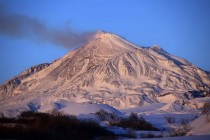
Photo when Bezymianny was quiet and skies clear
By Charles Q. Choi, Our Amziang Planet
The eruption of a volcano in Iceland is often blamed for the unusually harsh winter of 1783 to 1784 around the North Atlantic. But new research lays the blame for the extreme cold elsewhere.
Scientists find that the extremes of cold back then might actually have been triggered by the same climate effects potentially responsible for the unusually cold and snowy winter that Europe and North America experienced from 2009 to 2010.
These new findings shed light on how extremes in natural variability in climate have played - and still play - a key role in our world today, along with any recent global warming effects, the researchers said.
Laki erupts
Iceland’s Laki volcano began erupting on June 8, 1783, and continued doing so for months, causing a major environmental disaster. The volcano spewed out toxic fumes that spread over northern latitudes, causing about 23,000 deaths in Britain alone.
The summer of 1783 saw heat waves, extreme cold, widespread famines, crop failures and livestock losses - a crisis that might have even hastened the French Revolution. The following winter, record cold was seen around the North Atlantic. Temperatures in Europe were about 3.6 degrees Fahrenheit (2 degrees Celsius) below average for the late 1700s, and the winter was also one of the coldest of the past 500 years in eastern North America.
The Laki eruption has been blamed for that exceptionally deadly winter. But the new findings now may exonerate the volcano. Instead of its ashes and gas triggering a colder winter, scientists suggest that the cold snap might have been caused by an unusual combination of climate effects that apparently are similar to those that made the 2009 to 2010 winter so bitter in western Europe and eastern North America.
Then and now
In the winter of 2009 to 2010, the North Atlantic Oscillation (NAO), a climate phenomenon in the North Atlantic sector, went through a negative phase, meaning less warm air flowed into Europe and more cold Arctic air headed toward North America. At the same time, the El Nino-Southern Oscillation (ENSO), a climate pattern in the tropical Pacific Ocean, went through a warm phase, which can potentially cause wetter, cloudier winters in northern Europe and enhanced storms to hit the central and southern latitudes of the United States.
After analyzing 600 years’ worth of data in tree rings, which preserve details about the climate in which the trees grew, the scientists found that NAO and ENSO conditions during the 1783 to 1784 winter were similar to those seen in the 2009 to 2010 winter. In ranking this kind of combined NAO-ENSO events, the researchers found that the 2009 to 2010 winter showed the strongest combined effects and the 1783 to 1784 winter the second strongest in the past 600 years.
At the same time, their simulations of the effects of the Laki eruption and its dissipation through the autumn of 1783 suggest that it did not play a key role in these events.
“What is most interesting to me is the ability to place recent climatic extremes - for example, the winter of 2009 to 2010 - into a long-term context using tree ring and other paleo-records,” Rosanne D’Arrigo, a dendrochronologist at the Lamont-Doherty Earth Observatory of Columbia University, told OurAmazingPlanet. “Our results indicate that natural variability and extremes still play an important role in our climate today, along with global warming effects.” H/T Marc Morano
By Tim Blair, AU Telegraph
Former Al Gore senior aide Leslie Dach dared to dream:
In July 2006, Dach was installed as the public relations chief for Wal-Mart. He drafted a number of other progressives into the company, seeking to change the company’s way of doing business: its culture, its politics, and most importantly its products.
Out went drab, inexpensive merchandise so dear to low-income Americans. In came upscale organic foods, “green” products, trendy jeans, and political correctness. In other words, Dach sought to expose poor working Americans to the “good life” of the wealthy, environmentally conscious Prius driver.
How did that all work out?
After suffering seven straight quarters of losses, today the merchandise giant Wal-Mart will announce that it is “going back to basics,” ending its era of high-end organic foods, going “green,” and the remainder of its appeal to the upscale market. Next month the company will launch an “It’s Back” campaign to woo the millions of customers who have fled the store.
Further from the Wall Street Journal:
Starting in May, Wal-Mart shoppers in the U.S. will see signs in stores heralding the return of fishing tackle, bolts of fabric and other ‘heritage’ merchandise that Wal-Mart reduced or cut out altogether as it attempted to spruce up its stores…
There’s a lesson here for all manner of mass-consumer businesses.
By John Nicol, Doomed Planet
Global warming research: whatever happened to the scientific method?
Global warming, and its euphemistic sibling “climate change”, remain much in the news. Specialist research groups around the world continue to produce an unending sequence of papers aimed at demonstrating a litany of problems which might arise should global warming resume. The authors’ prime expertise is often found to be not in atmospheric physics or aeronomy, as one might have anticipated. However, the topic of climate change itself provides for abundant research funding, from which they feed, more easily than other areas of research of greater interest and practical use. Most of these papers are, of course, based upon the output from speculative and largely experimental, atmospheric models representing exercises in virtual reality, rather than observed, real-world, measurements and phenomena. Which leads to the question “What scientific methodology is in operation here?”
Though much has been written concerning the scientific method, and the ill defined question as to what constitutes a correct scientific approach to a complex problem, comparatively little comment has been made about the strange mix of empirical and virtual reality reasoning that characterises contemporary climate change research. It is obvious that the many different disciplines described as being scientific, rather than social, economic, or of the arts, may apply somewhat different criteria to determine what fundamental processes should define the “scientific method” as applied for each discipline. Dismayingly, for many years now there has been a growing tendency for many formerly “pure” scientific disciplines to embody characteristics of many others, and in some cases that includes the adoption of research attitudes and methods that are more appropriately applied in the arts and social sciences. “Post-modernism”, if you like, has proved to be a contagious disease in academia generally.
Classical scientific method generally follows the simple protocol of first defining an hypothesis concerning the behavior or cause of some phenomenon in nature, either physical, biological or chemical. In most well defined areas of research, previous theory and experiment may provide such a wide and complex corpus of knowledge that a new hypothesis is not easily nor singly defined, and may even be left unstated.
This is most commonly the case when a number of diverse disciplines, all important for attaining an understanding of a particular problem, are providing results which lead to contradicting conclusions. A contemporary example of this is discussions of the greenhouse effect, which is one of the most controversial topics ever to be considered within the scientific community. Conventional thinking on the greenhouse effect is encapsulated in the IPCC’s statement that “We believe that most of the increase in global temperatures during the second half of the twentieth century, were very likely due to the increases in the concentration of atmospheric carbon dioxide”.
Clearly this statement would be better worded were it to have been framed as a hypothesis rather than a belief, and treating the statement that way allows it to be rigorously tested ("beliefs", which are unable to be tested, fall outside of the spectrum of science). In the real scientific world, for such an hypothesis to survive rigorous scrutiny, and thereby to perhaps grow in strength from a hypothesis to a theory, requires that it be examined and re-examined from every possible angle over periods of decades and longer.
In conventional research, the next step - following the formulation of the hypothesis in whatever form it may take - is to select what measurements or analyses need to be done in order to test the hypothesis and thus to advance understanding of the topic. Most often, theoretical reasoning as to why an hypothesis might be correct or incorrect is followed by the development of experiments in laboratories, or the making of careful observations in nature, which can be organized and classified, and from which measurements can be made and conclusions drawn.
The theoretical analysis may be qualitative, highly structured or written in terms of a precise mathematical formalism, which provides a basis for describing a model or picture of the phenomenon and the behavior of observables associated with it. We may for instance, choose to include conjecture on quantities which are hidden from observation but whose presence and effects may be simply understood through the measured behavior of larger-scale observables. As work progresses, theoretical reasoning and experiment work in harmony, one or other progressing foremost at a given time, but they are inevitably locked together by the need to represent experimental observations and results in theoretical terms. The mandatory requirement in all of this is that all aspects of an hypothesis (and nascent theory) must be justifiable, meaning justified in terms of observation and measurement.
Examples of this process abound in physics where theoretical reasoning and experiment, have, since the days of Newton, Faraday and the other great masters, marched together in step. In some cases theory trailed the evidence, in others the reverse. Here are some historical examples, based upon familiar cases which are frequently referred to even in the popular press.
The development by Max Planck of the mathematical law that represents the natural distribution of radiation from a hot cavity followed a very long process of developing theoretical explanations to best fit the evidence from measurements that had been made as long as thirty years before. Intermediate steps along the way included the approximate formulae of Wein and Rayleigh, both of which provided reasonably accurate representations when Planck’s formula was applied to the extreme limits of the radiation field, but which proved to be less powerful and general in application than Planck’s final formulation. Later gestation of Plank’s embryo discovery led to the development of the powerful and technologically empowering quantum mechanics and electrodynamics theories. Along the way, again, there was a trail of experiments which sprang from the stimulation of theoretical reasoning yet simultaneously raised questions which required understanding through mathematical analysis. During all of this, mutually supportive yet competitive research, observation, experiment and theoretical reasoning, played off one another in a constructive, “scientific” fashion, leading eventually to the development of the laser, the transistor, the scanning electron microscope, the MRI, cat scan, cochlear hearing, the super and desk top computers and countless other modern technical and medical machines. Good, fundamentally sound scientific discoveries are gifts beyond price, that simply keep on giving.
The same type of history applied in the development of the acknowledged triumph that was Einstein’s theory of special relativity. Einstein’s breakthrough was built on the strong, earlier theoretical work of Lorenz and others, who provided the formalism that allowed the classical electromagnetic equations of James Clerk Maxwell to be seen as a universal description of electromagnetism. Thus was provided a basic description of the actions of light, X-rays and radar, while at the same time sweeping away a long held consensual belief in the luminescent ether, an erstwhile all pervading but undetectable substance that was proscribed as the carrier of light from the stars, the sun and man on earth. Looking back with the benefit of hindsight, “belief” in the ether shows many similarities with the strong belief that some modern scientists espouse that dangerous global warming is being caused by human-related carbon dioxide emissions.
Maxwell’s equations grew directly from Faraday’s classical experiments. Einstein’s theory placed these equations in a universal framework. Quantum electrodynamics harnessed Maxwell and Planck into modern quantum theory, while relativity itself remains largely a curiosity in spite of its importance in placing other theories and experimental results into a robust description of important aspects of nature. Nevertheless, all of these theories, and the results of early experiments which sought either to justify or destroy them, continue to be placed under the most careful contemporary research scrutiny, on scales that range from examination of the smallest particles in nature to the cosmological description of the universe.
As long as 70 years after the acclaimed publication of Einstein’s Relativity theory, experiments were still being conducted using refined laser techniques in attempts to show that some vital predictions flowing from this theory were invalid. Over the same period, conceptual acceptance occurred of the implications of the so-called “Twin Paradox” which also followed from this theory, which led to a Herculean battle between two unforgiving protagonists, H.W. McRea and Herbert Dingle, in a series of articles published in Nature. Subsequently, and appropriately, the answer was defined by an experiment - to whit, the measurement of the decay of a radioactive sample traveling by satellite. Einstein’s less commonly described General Theory of Relativity is still undergoing constant review in most of its parts - as, to some minor extent, is the special theory also. The important point to absorb here is that ALL scientific results are provisional, as well encapsulated by Nobel Prize winner Richard Feynmann’s immortal observation that “A scientist is someone who believes in the ignorance of experts”.
In all of this turbulent and adversarial history of fundamental truths of nature, there has been robust argument amongst many varied scientists and research groups, but against a background of respect between all participants. There has always been a liberal sharing of ideas, at the same time as a strong defense was offered by an individual of his own. The incontrovertible historic evidence of the rapid exchange of ideas by means of publications of short letters and articles during these phases of scientific creativity is proof positive of the importance of freedom of data sharing and information at a level of which many modern scientists can only dream.
That some meteorological agencies and “leading” climate scientists believe that they have the right to deny provision of their data to other credentialed scientists is but one of the signs of a research pathology that characterizes many powerful, contemporary climate science teams.
Electromagnetism, relativity and quantum mechanics are now very generally accepted, not least because they have been thoroughly tested by a large range of differing experimental approaches. Nonetheless, controversies still exist in discussions of the fine details of the theory, while at the same time the results of more exotic measurements are seriously questioned if they do not fit the theory. This process of continuous testing of both theory and experiment has the tremendous benefit in stimulating further experiments and differing hypotheses which often lead to new discoveries. In all of this, the Plancks, Bohrs, Diracs, Einsteins, Heisenbergs and Schrodingers stood way out from the crowd, as do their modern counterparts to this very day.
Just as there were debates on relativity, there were also some serious sceptics in the quantum world, some of whom used the debate between Einstein and Bohr on the interpretation of the equations of Quantum Mechanics to discredit it. In the end, Bohr’s so-called Copenhagen interpretation prevailed, which describes a quantum world of probabilities that lie within a proscribed range of an unrelenting uncertainty. Einstein’s claim that “Der liebe Gott würfelt nicht mit der Welt” now has few supporters, but followed him to the grave. Among other notable antagonists of quantum theory, Professor Frederick Lindemann (Viscount Cherwell) at the Clarendon Laboratory in Oxford, would not allow the teaching of quantum mechanics in his classes right up until the 1940s
Out of this cut and paste “history” of physics, comes the strongest criticism of the mainstream climate science research as it is carried on today. The understanding of the climate may appear simple compared to quantum theory, since the computer models that lie at the heart of the IPCC’s warming alarmism don’t need to go beyond Newtonian Mechanics. However, the uncertainty in Quantum Mechanics which Einstein was uncomfortable with, was about 40 orders of magnitude (i.e. 10^40) smaller than the known errors inherent in modern climate “theory”. Yet in contemporary research on matters to do with climate change, and despite enormous expenditure, not one serious attempt has been made to check the veracity of the numerous assumptions involved in greenhouse theory by actual experimentation.
The one modern, definitive experiment, the search for the signature of the green house effect has failed totally. Projected confidently by the models, this “signature” was expected to be represented by an exceptional warming in the upper troposphere above the tropics. The experiments, carried out during twenty years of research supported by The Australian Green House Office as well as by many other well funded Atmospheric Science groups around the world, show that this signature does not exist. Where is the Enhanced Green House Effect? No one knows.
In addition, the data representing the earth’s effective temperature over the past 150 years, show that a global human contribution to this temperature can not be distinguished or isolated at a measurable level above that induced by clearly observed and understood, natural effects, such as the partially cyclical, redistribution of surface energy in the El Nino. Variations in solar energy, exotic charged particles in the solar wind, cosmic ray fluxes, orbital and rotational characteristics of the planet’s motion together provide a rich combination of electrical and mechanical forces which disturb the atmosphere individually and in combination. Of course, that doesn’t mean that carbon dioxide is not a “greenhouse gas”, so defined as one which absorbs radiation in the infra red region of the spectrum. However, the “human signal”, the effect of the relatively small additional gas that human activity provides annually to the atmosphere, is completely lost, being far below the level of noise produced by natural climate variation.
So how do our IPCC scientists deal with this? Do they revise the theory to suit the experimental result, for example by reducing the climate sensitivity assumed in their GCMs? Do they carry out different experiments (i.e., collect new and different datasets) which might give more or better information? Do they go back to basics in preparing a new model altogether, or considering statistical models more carefully? Do they look at possible solar influences instead of carbon dioxide? Do they allow the likelihood that papers by persons like Svensmark, Spencer, Lindzen, Soon, Shaviv, Scafetta and McLean (to name just a few of the well-credentialed scientists who are currently searching for alternatives to the moribund IPCC global warming hypothesis) might be providing new insights into the causes of contemporary climate change?
Of course not. That would be silly. For there is a scientific consensus about the matter, and that should be that.
A Forecasting Expert Testifies About Climate ChangePublished: April 10, 2011
In ”The Truth, Still Inconvenient” (column, April 4), Paul Krugman begins with a “joke” about “an economist, a lawyer and a professor of marketing” walking into a room, in this case to testify at a Congressional hearing on climate science.
I am the marketing professor, and I was invited to testify because I am a forecasting expert.
With Dr. Kesten C. Green and Dr. Willie Soon, I found that the global warming alarm is based on improper forecasting procedures. We developed a simple model that provides forecasts that are 12 times more accurate than warming-alarm forecasts for 90 to 100 years ahead.
We identified 26 analogous situations, such as the alarm over mercury in fish. Government actions were demanded in 25 situations and carried out in 23. None of the alarming forecasts were correct, none of the interventions were useful, and harm was caused in 20.
Mr. Krugman challenged 2 of the 26 analogies, “acid rain and the ozone hole,” which he said “have been contained precisely thanks to environmental regulation.” We are waiting for his evidence.
“What’s the punch line?” he asked. I recommended an end to government financing for climate change research and to associated programs and regulations. And that’s no joke.
J. SCOTT ARMSTRONG
Philadelphia, April 6, 2011
The writer is a professor at the Wharton School, University of Pennsylvania.
ICECAP NOTE: See this recent post
Forecasting Expert Calls for End to Government-Funded Research on Global Warming
Heartland Press Release
In testimony yesterday before the Subcommittee on Energy and Environment Committee on Science, Space and Technology, forecasting expert J. Scott Armstrong of the Wharton School at the University of Pennsylvania called on Congress to cease funding global warming research, programs, and advocacy organizations.
Referring to an analysis he conducted with Kesten C. Green of the University of South Australia and Willie Soon of the Harvard-Smithsonian Center for Astrophysics, Armstrong told the subcommittee, “We approach the issue of alarm over dangerous manmade global warming as a problem of forecasting temperatures over the long term. The global warming alarm is not based on what has happened, but on what will happen. In other words, it is a forecasting problem. And it is a very complex problem.”
The three researchers audited the forecasting procedures used by the Intergovernmental Panel on Climate Change (IPCC), whose “procedures violated 81% of the 89 relevant forecasting principles,” Armstrong noted.
Armstrong and his colleagues recommend Congress end government funding for climate change research as well as other research, government programs, and regulations that assume the planet is warming. They also recommend Congress cease funding organizations that lobby or campaign for global warming.
“Based on our analyses, especially with respect to the violations of the principles regarding objectivity and full disclosure,” Armstrong told members of Congress, “we conclude that the manmade global warming alarm is an anti-scientific political movement.”
Armstrong can be reached for further comment at 610-622-6480 or armstrong@wharton.upenn.edu. A copy of the report he submitted to the committee is available online.
By Joseph D’Aleo, CCM, WeatherBell
Snow as the first week of April drew a close was still extensive across Canada and Asia. It remains well above the normal as it did the entire winter.
Meanwhile the Gulf of Mexico has warmed above normal due to the southeast ridge the last 6 weeks.
The means more then normal north to south contrast and moisture aplenty to help feed spring severe weather activity. Normally La Nina springs have more severe weather activity as have posted earlier.
Last Monday, April 4th was one of the most active days in recent memory for the Storm Prediction Center and folks who live in the southeast with 1347 severe weather reports (1220 high wind, 89 hail and 38 tornado) from the Ohio River southeast to northern Florida. Virtually everyone in the southeastern United States felt the fury.
See this link for a listing of all the 1347 reports.
April and May should keep forecasters busy. In my first WeatherBell post, I discussed the potential for some very big severe weather days as is the case in La Nina years in a cold PDO (Pacific Decadal Oscillation). The Palm Sunday outbreak in 1965 and the Superoutbreak in 1974 were just two prime examples.
The Palm Sunday tornado outbreak on April 11, 1965 involved 47 tornadoes (15 significant, 17 violent, 21 killers) hitting the Midwest. It was the second biggest outbreak on record. In the Midwest, 271 people were killed and 1,500 injured (1,200 in Indiana). It was the deadliest tornado outbreak in Indiana history with 137 people killed. The outbreak also made that week the second most active week in history with 51 significant and 21 violent tornadoes. The tornado which hit Midway trailer park is disputed to be an F5, as 25 homes were literally and figuratively wiped off the face of the earth, with no signs of them ever found.
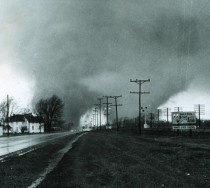
NOAA image for the famous Elkhart, IN double funnel tornado that hit the Midway Trailor Park.
The Super Outbreak of April 3–4, 1974 spawned 148 confirmed tornadoes across eastern North America and resulted in the second highest death toll (319) in the United States. Not only did it produce an exceptional number of tornadoes, but it was also an inordinately intense outbreak producing dozens of large, long-track tornadoes, including 7 F5 and 23 F4 tornadoes. More significant tornadoes occurred within 24 hours than any other week in the tornado record.
Severe weather is likely today and tomorrow with moderate risks both days.
You can see the moisture (precipitable water - total water in inches in the atmospheric column) in this early Saturday analysis with the radar showing showers and thunderstorms.
See more on WeatherBell posts by Joe Bastardi and I.
The Regional Greenhouse Gas Initiative, or RGGI, is designed to reduce greenhouse gas emissions 10-percent by 2018.
But now, three of the 10 states in the initiative are considering withdrawing, in part because of the cost to electric ratepayers.
As part of a collaboration with Northeast stations, Amy Quinton with New Hampshire Public Radio reports.
The goal of the Regional Greenhouse Gas Initiative is to make polluters pay while raising millions of dollars for energy efficiency and renewable energy projects.
It requires power plants to buy one pollution credit at auction for every ton of greenhouse gases they release.
So far those auctions have netted more than 860 million dollars.
But now, some lawmakers in three states - New Hampshire, Maine, and New Jersey - want to get out of RGGI.
“We should have never joined in the first place.”
That’s New Hampshire Republican Representative Jim Garrity speaking on the house floor.
“RGGI should be repealed now because it rests on shaky economic science, namely that the government should collect some money from all of us, to redistribute that wealth to a few of us.”
Garrity says not everyone gets RGGI money to pay for energy efficiency projects.
He and other Republicans have referred to RGGI as a hidden carbon tax that’s passed on to electric ratepayers.
Legislation to repeal New Hampshire’s participation in RGGI recently passed the house, but has yet to pass the Senate.
Dan Soslund, with the group Environment Northeast, says the move in New Hampshire is discouraging.
“I think the public deserves to hear their elected officials talk about policy direction based on facts and the facts are that RGGI has had almost no quantifiable bill impact”
But electric bills for residential customers in the Northeast have increased slightly because of RGGI.
In 2010, it cost an extra 28 to 68 cents a month according to RGGI Inc.
Ross Gittell, an economist with the University of New Hampshire, says electric bills won’t decrease if the state withdraws from RGGI because New Hampshire is part of a regional power grid.
“If we don’t participate in RGGI, we will pay some of its costs, and we will not get the benefits in the form of carbon allowance revenue that we receive which is quite significant.”
Critics of the program point out that New Hampshire, New Jersey and New York diverted some of that RGGI revenue to fill their budget gaps.
New Hampshire is not only state attacking RGGI.
In Maine, Republican Senator Tom Saviello is sponsoring a bill that would withdraw his state from RGGI.
΄We need to ask this question, number one do we want to put the extra cost on our electricity, and number two if these energy efficient projects are that good, which everybody says they are, well then a business should be willing to put their own money into it, why should we be subsidizing that.”
If Maine and New Hampshire withdraw from RGGI, analysts say the program is still likely to continue.
That may be because Maine and New Hampshire don’t release a lot of greenhouse gases.
So the number of pollution credits they sell at auction is small.
But New Jersey’s Governor is also talking about withdrawing from RGGI.
That state makes up 12 percent of the carbon market.
Anthony Leiserowitz, with the Yale University Project on Climate Change, says if New Jersey steps out it could deal a death blow to RGGI.
“How it plays nationally however is that it just seems to accelerate this sense that the country as a whole and in particular Republicans and Conservatives in this country are really climbing out on a limb farther and farther away from climate science.”
Leiserowitz says RGGI does more than reduce carbon emissions in the Northeast. If RGGI stays intact, it could be a model for the rest of the country.
Icecap Note: that is so all the rest of you can suffer too. Europe’s Green subsidy experiment failed with not only increased energy costs putting more people in energy poverty, but every green job cost 2.2 real jobs in Spain, 3.4 in the Uk and over 4 in Italy. In all cases the CO2 emissions went up not down as coal fired back up plants were required to meet the real energy needs that the unreliable renewables could not. Many industries moved plants to India or China to maintain profits. It is a pie in the sky enviro, ivory tower university scheme that doesn’t work. There are many examples of dismal failures in trying to control what doesn’t need control - the mercury carrying and expensive CFLs, the forced non use of DDT with tens of millions of excess malaria deaths, the imposed poverty in the third world through prohibition of power plants, and on and on. CO2 is not a pollutant, not a health hazard but a benefactor, a plant fertilizer. All life on the planet depends on it.
Noami Oreskes wrote a book about skeptics - “Merchants of Doubt”. She represents a movement about which a book could be written “Merchants of Death”. This is hard for me to say, a former environmentalist in my youth. But the movement has been hijacked by those who profess it is all about science but act with a political and social (asocial) agenda and who are benefiting hugely from government grants and subsidies.
Hat Tip thanks to Eric Werme, who joined me and two other scientists in public hearings in NH and has maintained a web page on the RGGI repeal battle here.
UAH UPDATE:
The UAH March numbers are in. March 2011 was coolest in more than a decade.
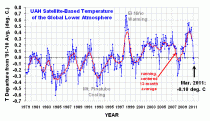
Enlarged.
Global Temperature Report: March 2011
Global composite temp.: -0.10 C (about 0.18 degrees Fahrenheit) below the 30-year average for March.
Northern Hemisphere: -0.07 C (about 0.13 degrees Fahrenheit) below 30-year average for March.
Southern Hemisphere: -0.13 C (about 0.23 degrees Fahrenheit) below 30-year average for March.
Tropics: -0.35 C (about 0.63 degrees Fahrenheit) below 30-year average for March.
Driven by the La Nina Pacific Ocean cooling event, global average temperatures in March 2011 were the coolest March since 1999, according to Dr. John Christy, professor of atmospheric science and director of the Earth System Science Center at The University of Alabama in Huntsville.
It was the fifth coolest March in the tropics, where the average temperature fell 0.35 C (about 0.63 degrees Fahrenheit) below seasonal norms. Three of the five coldest tropical Marches in the 33-year satellite temperature record have happened in the past dozen years: 5th, 2011, -0.35 C: 3rd, 2000, -0.42; and 2nd, 2008, -0.58 C.
---------------
Steve Goddard reports (H/T Marc Morano)
Hansen, March 31
“Based on subsurface ocean temperatures, the way these have progressed the past several months, and comparisons with prior El Ninos, we believe that the system is moving towards a strong El Nino starting this summer. it’s not a sure bet, but it is probable.”
By Joseph D’Aleo, CCM, on WeatherBell
The La Nina has weakened in the late winter and early spring, as most do.
The cold water in the eastern Pacific has become patchy. Some of the ENSO models have been predicting the bounce back to El Nino. The NASA GMAO model was the most aggressive in this regard taking it to a borderline strong El Nino.
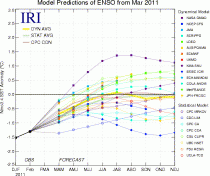
Enlarged
This weakening happened in 2008 after the La Nina winter of 2007/08 we actually warmed above normal even to the central Pacific briefly before cooling resumed. We covered this is some detail in this recent post.
The Southern Oscillation Index (SOI) if El Nino was coming on would be strongly leading the charge by dropping into negative territory. You can see how positive it has been in the last year.
See how it 2008 it dipped in July to a slight negative before rebounding into the second La Nina winter before El Nino conditions kicked in by the summer of 2009.
The last 30 days the SOI has been dramatically positive, just three days ago spiking to more than 7.5 STD positive (La Nina). This will enhance the easterlies in the tropical zone.
Indeed the new CFS ensemble model (version 2) has in many of the latest forecast models shown a dramatic late year cooling after the rebound into the early summer.
This fits better the ENSO pattern in the cold (negative) PDO - we tend to get more La Ninas and they tend to last longer than the El Ninos, the opposite of the warm PDOs.
See post and others on WeatherBell.
Note: Hansen and the warmers think of El Ninos as their friend and La Ninas as a temporary nuisance that stops the warming. The difference between El Nino peaks and La Nina troughs have been in the 13 month running average about 0.5C (0.9F). Clearly one of the reasons we saw warming between 1979 and 1998 was we had 3 times as many El Ninos which lasted twice as long as La Ninas. That is why you will never hear a warmist speak about PDO though they will (have to) use La Ninas as an excuse for when it cools.
Neville Nicholls on Australia’s Extreme RainfallBy Roger Pielke Jr.
Neville Nicholls is one of Australia’s leading climate scientists. He is also a long-time participant in the IPCC and current president of the Australian Meteorological & Oceanographic Society. I first met Neville in the mid 1990s (at a meeting in Vietnam I think) and I have had nothing but great respect for him ever since. In his latest “AMOS - President’s Column” he asks, “What caused the eastern Australia heavy rains and floods of 2010/11?”
He begins his answer by pointing to the strength of the current record La Nina event and the relationship of the SOI (Southern Oscillation Index, a measure of the strength of La Nina and El Nino events) and Australian rainfall (see his figure above). He concludes:
Given the well-known relationship between the SOI and heavy rains in eastern Australia (eg., McBride and Nicholls, 1983) we can conclude that the fundamental cause of the heavy rains this past six months was indeed this record La Nina event. Other heavy rain years (1917/18, 1950/51, 1973/74, 1975/76) were also the result of strong La Nina events. The relationship between rainfall and the SOI is very strong, with a correlation coefficient of 0.66. So, the heavy rains were not caused by global warming, but by a record La Nina event - a natural fluctuation of the climate system.
But he doesn’t stop there. He next asks: “But perhaps 2010/11 was a record La Nina because of global warming?” His answer:
There has not been any trend in the SOI over the past 111 years, despite the warming of global mean temperature of about 0.75C over that period. Nor do climate models consistently predict increased strength of La Nina events from enhanced atmospheric content of greenhouse gases (eg., Vecchi and Wittenberg, 2010). So there is no reason, at this moment, for us to suspect that global warming is increasing the frequency or intensity of La Nina events.
He doesn’t stop their either, and next asks, “But was the impact of the 2010/11 La Niña on Australian rainfall stronger because of the record warm sea surface temperatures around northern Australia in 2010?” His answer:
These waters have increased substantially over the last century and are now about a degree warmer than early in the 20th century. If these warmer waters were enhancing the impact of La Nina on Australian rainfall we might expect to be seeing heavier rains in recent decades, relative to the rains that accompanied earlier strong La Nina events. There is some evidence of this (eg., Nicholls et al 1996), and there has been a weak tendency towards increased rainfall since 1900, independent of the influence from the El Nino - Southern Oscillation. Perhaps this trend towards increased rainfall might be related to the warmer sea surface temperatures - but much more work is needed to test this. The effect, if there is one, does not look very strong.
He concludes:
The record La Nina event was the fundamental cause of the heavy rains and floods, ie it was a natural fluctuation of the climate system. There may be a global warming signal enhancing this natural variability, but if so then this effect has been quite subtle, at least thus far.
Post. See also Stewart Franks’ story on Jennifer Marohasy’s blog about Better planning for floods in Australia - using ther combination of PDO and La Nina.
By Willis Eschenbach, Watts Up With That
Well, I had hoped for the best from BEST, the new Berkeley Earth Surface Temperature project looking at the global temperature record. I was disheartened, however, by the Congressional testimony of Dr. Richard Muller of BEST.
He said (emphasis mine):
Global Warming
Prior groups at NOAA, NASA, and in the UK (HadCRU) estimate about a 1.2 degree C land temperature rise from the early 1900s to the present. This 1.2 degree rise is what we call global warming. Their work is excellent, and the Berkeley Earth project strives to build on it.
Human caused global warming is somewhat smaller. According to the most recent IPCC report (2007), the human component became apparent only after 1957, and it amounts to “most” of the 0.7 degree rise since then. Let’s assume the human-caused warming is 0.6 degrees.
The magnitude of this temperature rise is a key scientific and public policy concern. A 0.2 degree uncertainty puts the human component between 0.4 and 0.8 degrees - a factor of two uncertainty. Policy depends on this number. It needs to be improved.

The preliminary comparison - the 2% data is from Japan. H/T Steve Goddard
Why do I think his testimony doesn’t help in the slightest? Well, to start with, I’ve never heard anyone make the claim that the land surface air temperature (excluding oceans) of the earth has warmed 1.2C since 1900.
He cites three land temperature datasets, NOAA , NASA (GISTEMP), and HadCRU (he presumably means CRUTEM, not HadCRU).
Here’s the problem. The actual land surface air temperature warming since 1900 according to the existing datasets is:
NASA GISTEMP: 0.72C
NOAA NCDC: 0.86C
CRUTEM: 0.92C
So Dr. Muller, in his first and most public appearance on the subject, has made some of the more unusual claims about the existing temperature datasets I’ve heard to date.
1. Since the largest temperature rise in the three datasets is 30% greater than the smallest rise, their work is not “excellent” in any sense of the word. Nor should the BEST team “strive to build on it.” Instead, they should strive to understand why the three vary so widely. What decisions make the difference? Which decisions make little difference?
2. Not one of the three datasets shows a temperature rise anywhere near the 1.2C rise Muller is claiming since 1900. The largest one shows only about 3/4 of his claimed rise.
3. He claims a “0.2 degree uncertainty”. But the difference between the largest and smallest calculated warming from the three datasets is 0.2C, so the uncertainty has to be a lot more than that
4. He says that the land warming since 1957 is 0.7C. The records beg to differ. Here’s the land warming since 1957:
NASA GISTEMP: 0.83C
NOAA NCDC: 1.10C
CRUTEM: 0.93C
Note that none of them are anywhere near 0.7C. Note also the huge difference in the trends in these “excellent” datasets, a difference of half a degree per century.
5. He fails to distinguish CRUTEM (the land-only temperature record produced by the Climategate folks) from HadCRU (a land-ocean record produced jointly by the Hadley folks and the Climategate folks). A minor point to be sure, but one indicating his unfamiliarity with the underlying datasets he is discussing.
It can’t be a Celsius versus Fahrenheit error, because it goes both ways. He claims a larger rise 1900-present than the datasets show, and a smaller rise 1958-present than the datasets.
I must confess, I’m mystified by all of this. With his testimony, Dr. Muller has totally destroyed any credibility he might have had with me. He might be able to rebuild it by explaining his strange numbers. But to give that kind of erroneous testimony, not in a random paper he might written quickly, but to Congress itself, marks him to me as a man driven by a very serious agenda, a man who doesn’t check his work and who pays insufficient attention to facts in testimony. I had hoped we wouldn’t have another temperature record hag-ridden by people with an axe to grind....foolish me.
Perhaps someone who knows Dr. Muller could ask him to explain his cheerleading before Congress. I call it cheerleading because it certainly wasn’t scientific testimony of any kind I’m familiar with. I hear Dr. Muller is a good guy, and very popular with the students, but still… color me very disappointed.
PS - Muller also said:
Let me now address the problem of Poor Temperature Station Quality
Many temperature stations in the U.S. are located near buildings, in parking lots, or close to heat sources. Anthony Watts and his team has shown that most of the current stations in the US Historical Climatology Network would be ranked “poor” by NOAA’s own standards, with error uncertainties up to 5 degrees C.
Did such poor station quality exaggerate the estimates of global warming? We’ve studied this issue, and our preliminary answer is no.
The Berkeley Earth analysis shows that over the past 50 years the poor stations in the U.S. network do not show greater warming than do the good stations.
Thus, although poor station quality might affect absolute temperature, it does not appear to affect trends, and for global warming estimates, the trend is what is important.
Dr. Muller, I’m going to call foul on this one. For you to announce your pre-publication results on this issue is way, way out of line. You get to have your claim entered into the Congressional Record and you don’t even have to produce a single citation or publish a paper or show a scrap of data or code? That is scientific back-stabbing via Congressional testimony, and on my planet it is absolutely unacceptable.
That is taking unfair advantage of your fifteen minutes of fame. Show your work and numbers like anyone else and we’ll evaluate them. Then you may be able to crow, or not, before Congress.
But to stand up before Congress as an expert witness and refer solely to your own unpublished, uncited, and un-verifiable claims? Sorry, but if you want to make that most public scientific claim, that bad siting doesn’t affect temperature trends, you have to show your work just like anyone else. If you want to make that claim before Congress, then PUBLISH YOUR DATA AND CODE like the rest of us mortals. Put your results where your mouth is, or if not, leave it out of your Congressional testimony. Why is that not obvious?
Anthony’s unpublished and unverifiable claims are as strong as your similar claims. That is to say, neither have any strength or validity at all at this point ....so how would you feel if Anthony trotted out his unverifiable claims before Congress to show that Dr. Richard Muller was wrong, and didn’t show his work?
Like I said ...color me very disappointed, both scientifically and personally. Dr. Muller, I invite you to explain your Congressional testimony, because I certainly don’t understand it. I am totally confident that Anthony will be happy to publish your reply.
I also urge you to either a) publish the data and code that you think shows no difference in trends between good and poor stations, or b) publicly retract your premature and unverifiable claims. You don’t get to do one without the other, that’s not scientific in any sense of the word.
PPS - Does any of this mean that the BEST analysis is wrong or their numbers or data are wrong or that the BEST folks are fudging the results? ABSOLUTELY NOT. I am disappointed in Dr. Muller’s claims and his actions. The math and the data analysis is an entirely different question. Theirs may be flawless, we simply don’t know yet (nor would I expect to, it’s early days). I look forward to their results and their data and code, this kind of initiative is long overdue.
I want to be very clear than the validity of their actual methods depends only on the validity of their actual methods. The problem is, we don’t even know exactly what those methods are yet. We have rough descriptions, but not even any pseudocode, much less code. Which in part is why I find Dr. Muller’s testimony unsettling… 
By Joseph D’Aleo, CCM
In the LA Times, there was a story on Richard Muller’s invitation to DC to testify to congress about the Berkeley Project, which attempts to reconstruct global data
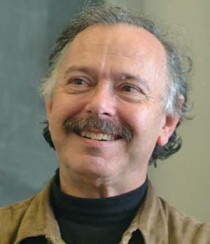
The Berkeley Earth Surface Temperature study is led by physicist Richard Muller, a longtime critic of the scientific consensus on climate change, who plans to testify on the effort Thursday before the House Science Committee in the latest of several congressional inquiries on climate science since the GOP majority was seated. Temperature data from tens of thousands of weather stations across the globe, many of which have incomplete records, are “very contentious,” Muller said in an interview. “The skeptics are raising legitimate concerns.”
Muller and many of those who question the temperature data are drawn to the “urban heat island” phenomenon, maintaining that gauges may be registering latent heat from asphalt, concrete and other urban features. Over time, some weather stations that once recorded temperatures in rural areas have been surrounded by cities and suburbs. The Berkeley project is analyzing information from 39,000 stations -five times as many as the other groups, Muller said - and will address the fact that temperature data have been recorded at varying times of day.
The project also will put its calculations on the Internet in a “transparent” way, Muller said. Other scientists, he said, “put homogenized data online. They don’t put up the [software] tools that get you from the raw data to the homogenized data. How do they pick the [weather station] sites? That involves human judgment.”
Peter Thorne, a leading expert on temperature data at the National Oceanic and Atmospheric Administration’s National Climatic Data Center in Asheville, N.C., said the three main data sets by the NOAA, NASA and Britain’s Hadley Centre adjust for the heat island effect, as well as for measurements at different times of day. Muller’s use of 39,000 weather stations, he said, “will make next to no difference” in the final result.
First of all the Berkeley Project’s approach to the data when stations move or siting changes - treating them like separate stations makes sense. Almost invariably the change in siting leads to a warm bias in trends.
Second and most importantly, Thorne must know that NOAA and Hadley don’t adjust for urbanization. In fact their homogenization approach urbanizes good rural station data sets. NOAA removed a UHI adjustment based on Karl (1988) in 2007 for the US 1221 station network (USHCN v2). NASA attempts an urban adjustment using night lights but McIntyre and others have shown the poor metadata (precise GIS locations) make matching satellite brightness and stations difficult.
In a story last year on Climate Science “Erroneous Statement By Peter A. Stott And Peter W. Thorne In Nature”, Roger Pielke Sr. wrote:
This is deliberately erroneous as one of the authors of this article (Peter Thorne) is an author of a CCSP report with a different conclusion. With just limited exceptions, the surface temperature data sets do not use different sources of data and are, therefore, not independent. As I have written, “The raw surface temperature data from which all of the different global surface temperature trend analyses are derived are essentially the same. The best estimate that has been reported is that 90–95% of the raw data in each of the analyses is the same (P. Jones, personal communication, 2003).”
Peter Stott and Peter Thorne have deliberately misled the readership of Nature in order to give the impression that three data analyses collaborate their analyzed trends, while in reality the three surface temperature data sets are closely related.
Muller meanwhile remains an enigma, like his partner in the project Judith Curry. He is an apparent semi-skeptic who believes AGW exists but is is greatly exaggerated .He and Judith and not thoroughly trusted by either side of the issue. This may mean they are getting it right. We can hope the project continues to be as promised independent and open source. NOAA, NASA, CRU are definitely not open source despite Thorne’s claims to the contrary. Their results are not currently replicable.
By Joseph D’Aleo, CCM
Snow was in the news a lot this winter in Europe, Asia and the United States. Numerous big cities had a season in their top ten. The storms this week may move some up. We will summarize in April. Even the Sierra has had mammoth snows. See the amazing pictures here.
Dr. Bob Hart at FSU maintains en excellent snow lab where he tracks hemispheric snowcover (with just a few day time delay) link.
Here is his plot of the Northern Hemispheric snowcover and anomaly as of March 27, 2011.
Notice how Asia and Canada are still covered and reflecting increasing insolation and thus still are in the production mode for cold air masses. Here you can see that it remains well above the climatology (1995-2009) as it has virtually continuously since late November.
Rutger’s snow lab shows in their seasonal analysis how the snow pack this past winter (2010/11) ranked #3 since records began in 1967 behind 2009/10 and 1977/78. Notice the trend is up for the winter.
The early and persistent snow helped keep the winter in Eurasia and the United States colder than normal.
Note last year the snow disappeared from much of the northeast and eastern Canada as persistent maritime flow around record blocking moderated the air enough to remove the snow early. See how last year was anomalously low in snowcover in the spring helping to exaggerate the downtrend.
That disappearing act for snow is what started us on a warm spring/hot summer path typical of La Nina summers after an El Nino winter (1999, 1995, 1988, 1966, etc).
With the spring starting out way ahead of last year, we get support for late cold and snow. We are seeing it in the models. JB and I have discussed the ideas of the cold and snow in late March for weeks and JB has blogged about more for April.
Here is what the analogs had suggested for March and what has happened through the 28th.
Here is what they suggest for April through June.
See how the CFS model views April, May June for temperatures
And the Soil Moisture model for April, May and June.
Obviously soil moisture and snowcover are in tune with the global teleconnections and suggest a very different summer than last year. We will fine tune as the indices are updated. It also implies an active tornado season. The cold PDO, La Nina and still warm AMO also point towards more problems from the Atlantic than we experienced last year as JB has posted.
See WeatherBell post here. See earlier post on why increasing snowcover is not consistent with global climate change models here. Also see 30 exqamples of AGW scientists covering both sides of the fence.





